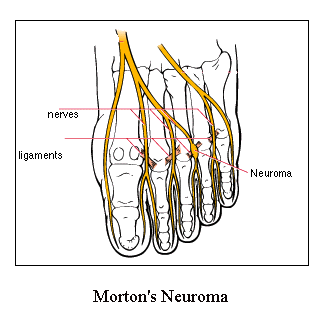
Morton’s neuroma, or interdigital neuroma, is a common foot injury that often leads to stopping sport. Nerve compression involving adjacent toe heads and ligaments may be the cause. The condition typically causes initial symptoms of dull cramping or burning pain and more persistent sharp pain with nerve deterioration. Depending on injury severity, treatment is either conservative or surgical
Morton’s neuroma is a benign, lesion of a common digital nerve. It affects females more frequently than males and is seen among patients of a wide range of ages. Typically it occurs at either the second or third intermetatarsal space, but it may also occur at other intermetatarsal spaces.

Various factors have been implicated in the onset of Morton’s neuroma, but Compression of digital nerves by the metatarsal or toe heads and the transverse intermetatarsal ligament appears to be a major cause.
Diagnosis
Symptoms of Morton’s neuroma are localized to the forefoot and toes. The condition may initially present as a dull ache or cramping sensation, with associated numbness. Tingling or burning radiating to the toes along with intermittent symptoms of sharp, shooting pain are reported with neuroma formation. Progression results in increased intensity and duration of symptoms, possibly spreading further. In chronic cases, patients may describe sensations of a hardened mass within the foot at the site of discomfort. Bending the toes may cause pain during walking or during forefoot weight-bearing activity, such as sprinting, jumping, squatting, or repeated hopping. Narrow-fitting footwear usually induces symptoms; relief is often reported with shoe removal or massage of the foot.
Clinically, examination reveals a palpable mass and usually reproduces pain that may radiate to the toes or along the course of the affected nerve. You may feel relative numbness at the web space supplied by the injured nerve.
Ultrasound imaging has been shown to accurately portray the location and magnitude of Morton’s neuroma.
Differential Diagnosis
A range of conditions may mimic Morton’s neuroma, including metatarsal stress fracture, metatarsophalangeal joint synovitis, intermetatarsal bursitis, extensor tendon tenosynovitis, tumour, and nerve injury more proximally. Metatarsal stress fracture will present with bony tenderness and pain upon palpation of the metatarsal shaft, rather than the common digital nerve. Metatarsophalangeal joint synovitis will often prove painful during active or passive joint motion.
Osteopathic Treatment
If Morton’s neuroma is detected early, conservative measures may be reasonably successful. Ice application may provide relief after sporting activity or may enable an athlete to complete the event if the ice is applied during a break in play. A pad or dome positioned over the heads of the central three toe heads may reduce symptoms.
Wearing good quality training shoes that offer suitable motion control and using foot orthotics may serve as ongoing methods treatment and prevention.
Your Osteopath will use specific techniques to help reduce inflammation and promote healing.